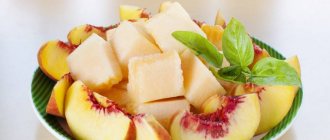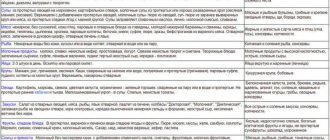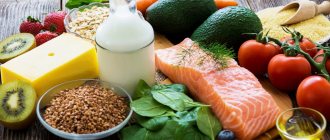Excess weight not only spoils a person’s figure, but is also the cause of many serious diseases. For example, already in a state of pre-obesity, a person’s sensitivity to insulin may decrease. This is called insulin resistance. Cells stop responding properly to the effects of insulin, which blocks the process of assimilation of glucose that enters the bloodstream when consuming carbohydrates. As a result, the pancreas, in order to improve the efficiency of the process of breakdown and absorption of glucose, increases the production of insulin. Over time, the body needs more and more insulin to function normally. When the need for it becomes too high and the body can no longer provide itself with the required amount, diabetes develops.
If you have insulin resistance, diabetes, or high insulin levels, it is important to lose weight. In the first case, this will help avoid the development of diabetes, and in the second, it will alleviate the general condition and improve the quality of life. Weight loss is a rather complex process that requires the support of specialists. For people with serious health problems such as type 2 diabetes, it is simply not safe to lose weight on their own. It is imperative to consult with experienced nutritionists, rehabilitation specialists, and psychologists, who should develop an individual comprehensive weight loss program. Only in this case can you count on a good result without risking further harm to your health. The Doctor Bormental clinic uses its own patented method of losing weight and maintaining results, with the help of which more than half a million people have already lost weight. Read more about the methodology here -.
General rules
There are certain rules, following which you can develop a high-quality convenient menu.
- The diet should contain mainly foods with low calorie content and a minimal glycemic index.
- You should first consult your doctor regarding fasting days. If doctors allow it, you can eat exclusively light, non-calorie foods once a week, reducing your daily caloric intake.
- You should avoid snacking and eat only properly prepared whole foods.
- Avoid fried foods.
- Avoid carbonated sweet drinks and replace them with clean water.
- Reduce salt intake.
- Calculate the menu so that the daily amount of calories consumed corresponds to the energy expended.
- Animal products should make up no more than a third of the total diet.
- Calculate the required amount of protein and introduce protein-containing foods in the required quantity.
- Eat at least 5 times a day in small portions.
- Schedule meals according to time, adhere to the established regime every day.
List of approved products
The diet of a person with insulin resistance or diabetes should consist of natural foods rich in proteins and vitamins. In this case, complex carbohydrates must be present in sufficient quantities. Nutritionists recommend consuming the following foods:
- buckwheat;
- fresh fruits except bananas, cherries and grapes;
- dried fruits;
- oatmeal;
- unprocessed rice;
- pumpkin;
- garlic;
- onion;
- mushrooms;
- kefir;
- fermented baked milk;
- yogurt;
- eggplant;
- radish;
- carrot;
- beet;
- potatoes (300 g per day)
- celery;
- cucumbers;
- pepper;
- salad;
- cabbage;
- beans;
- peas;
- cereal flakes.
To replenish protein you need:
- legumes;
- nuts;
- hard cheese;
- cottage cheese;
- eggs;
- chicken;
- beef;
- seafood;
- lean fish.
You can add a little butter, but you should give preference to fats of vegetable origin - corn oil, sesame oil, olive oil.
It is very important to provide the body with microelements necessary for proper metabolism. These substances increase sensitivity to insulin. These include: manganese, magnesium, chromium, zinc, copper.
What can you eat?
Authorized Products
- Greens: broccoli, spinach, cabbage, rosemary.
- Spices and herbs: cinnamon, turmeric, ginger, garlic, cumin, ginseng, pepper.
- Fruits and berries: blueberries, strawberries, gooseberries, mangoes, apples, grapes, oranges, cranberries, raspberries, currants.
- Mushrooms, tomatoes, onions, cucumbers, asparagus, beans, peas, zucchini, eggplant.
- Nuts, grains and beans: walnuts and hazelnuts, almonds, cashews, flax seeds, pumpkin seeds, beans.
- Cereals: brown, wild rice, buckwheat, oatmeal, wheat groats, pearl barley.
- Dairy: yogurt, kefir, low-fat milk, cottage cheese, tofu cheese.
- Protein group: eggs, quail, chicken, turkey, veal, rabbit, halibut, tuna, cod, perch, pollock, shrimp.
Prohibited Products
If you have insulin resistance, you should exclude:
- All types of sugar, including honey, syrup.
- White flour, pasta, bagels, baked goods, chips.
- Beer, alcohol and juices.
- Potatoes, sour cream and butter.
- Smoked meats in any form, fatty meats and fish.
- White rice, semolina.
- Bananas, cherries.
- Sweets, chocolate.
Excess weight
Malfunction of the pancreas is often associated with excess body weight. Moderation in diet and even minimal physical activity can lead to weight loss.
How to lose weight:
- Diet, you must clearly understand what you can eat.
- Physical exercise - every third day.
- Eat only on a schedule at the same time - three main meals and two snacks.
- Good dream.
What can you drink
Drinks containing sugar are prohibited for people with prediabetes. Therefore, store-bought juices and sweet waters should be excluded. You can drink large quantities of clean water, as well as self-prepared compotes, decoctions and sugar-free fruit drinks. Hot drinks allowed include coffee (1-2 cups per day) and green tea. They should also be drunk without sugar. But you can use natural sweeteners such as glycyrrhizin, fructose, stevia or regular honey. You should not use synthetic sweeteners, as they can be harmful to health and make you feel worse.
Not all permitted sweeteners can be used in unlimited quantities. The most harmless is glycyrrhizin. If you can’t drink unsweetened drinks and have to use a sweetener constantly, it’s better to use glycyrrhizin. Honey is very healthy, but can cause allergic reactions, and it is not suitable for a person losing weight. It can be consumed no more than 1 teaspoon per day. Fructose is an optimal sugar substitute, but you should not consume more than 25 g per day.
What is insulin resistance
Insulin resistance (hereinafter referred to as IR) is a short-term or long-term decrease in cell sensitivity to insulin.
As a result, blood sugar levels rise. With prolonged resistance, a number of symptoms and accompanying conditions develop.
What happens normally?
There is a cell, insulin and glucose. To function normally, a cell needs energy—glucose. Insulin acts as a transporter of glucose from the blood into the cell. Without insulin, glucose will NOT enter the cell.
After eating, blood sugar levels rise, and in response the pancreas produces insulin. The hormone helps glucose from the blood get into the cells: glucose is utilized, blood sugar is normal, cells are full - everything is fine.
What happens with insulin resistance?
For a number of reasons, the cell stops “listening” to insulin: glucose from the blood can no longer enter it. Glucose that is not utilized by cells accumulates in the blood, causing hyperglycemia.
Insulin resistance can appear both as an independent syndrome and as an addition to type 1/2 diabetes.
List of prohibited products
Products that contain fats and fast carbohydrates, and at the same time do not have useful substances, are not recommended:
- fast food dishes;
- semolina, millet, pearl barley;
- pork, lard;
- pasta and semi-finished flour products;
- sweet carbonated drinks;
- store-bought seasoned snacks;
- fried and fatty foods.
If a person’s menu consists mainly of the items listed above, we can safely talk about an eating disorder. To correct the situation and not lead to diabetes, you should contact a nutritionist and adjust your diet. Experts recommend removing prohibited foods gradually, one item per week.
In cases where a person has a serious addiction to favorite but unhealthy foods, switching to a new balanced diet may be too difficult. Often it ends in a breakdown and refusal to change eating habits. To avoid this, it is recommended not to remove prohibited food altogether, but to reduce its consumption to a minimum. For example, some nutritionists advise once a week to conduct a fasting day in reverse - during the day you eat everything familiar and unhealthy, but on the remaining 6 days you do not touch such food at all.
Insulin diet for weight loss
Guided by this technique, you do not limit yourself either in the amount of food or in the quality of products and will lose at least 5 kg. The system's designers rely on your common sense in these aspects of healthy eating. There are time limits for food consumption, and the composition of the dishes is no less important. All food during the day should be prepared according to the principle of separate meals.
During the insulin diet, three meals a day are required in the form of breakfast, lunch and dinner.
The interval between meals should be no more than 5 hours. Dinner - three hours before bedtime. Late-night snacking is strictly prohibited! You can't raise your insulin levels at night!
Rules
The main rule is not to eat at night. The rule works because it leads to a limitation in the production of hormones. It is necessary to reduce the formation of insulin.
Insulin and its role are important in metabolic processes. This hormone inhibits the activity of enzymes that break down fats. The more hormones in the human body, the slower the weight loss process. And the main stimulating substance affecting its production is glucose.
Blood glucose levels increase after eating. Therefore, it is necessary to avoid eating at night - the easiest way to curb insulin production at night, during rest.
Advantages and disadvantages of the diet
Pros:
- accessible menu;
- few restrictions;
- based on a healthy diet;
- no calorie counting;
- no additives;
- useful for those suffering from insulin imbalance.
Minuses:
- not for certain food allergies;
- a delicious menu can lead to gluttony;
- unsuitable for those who are sensitive to carbohydrates.
Diet menu for insulin resistance (Diet)
The diet of a person with insulin resistance should be varied and balanced. You need to include dishes that will bring pleasure and provide the body with all the necessary substances. Below is a sample menu for the week. It can be supplemented and modified depending on personal preferences, season, and capabilities.
Monday
Breakfast:
- tea or coffee (without sugar);
- 1 unsweetened fruit (orange, kiwi, green apple);
- omelette with low-fat milk (you can add vegetables or herbs).
2 breakfast:
- tea or unsweetened juice;
- tofu cheese (30 g);
- fruit salad with natural yogurt without additives.
Dinner:
- vegetable soup;
- steamed chicken (100 g);
- boiled brown rice (100 g);
- a glass of water or herbal tea.
Afternoon snack:
- cottage cheese with low-fat sour cream and dried apricots;
Dinner:
- pollock with vegetables, baked in the oven;
- juice or water.
2nd dinner:
- low-fat kefir (200 g).
Tuesday
Breakfast:
- a glass of fruit juice;
- oatmeal with water (100 g);
- seasonal berries (100 g).
2 breakfast:
- 1 orange or grapefruit.
Dinner:
- vegetable salad with herbs and olive oil;
- buckwheat porridge from unfried cereals (150 g);
- tomato juice or tea without sugar;
Afternoon snack:
- 2 green apples.
Dinner:
- steamed or oven-baked fish with seasonal vegetables;
- a glass of green tea or water.
2nd dinner:
- a glass of kefir.
Wednesday
Breakfast:
- tea or coffee without sugar;
- cottage cheese (100 g);
- dried apricots (50 g).
2 breakfast:
- 1 or 2 oranges.
Dinner:
- leafy vegetable salad dressed with olive oil;
- chicken broth with homemade noodles;
- brown rice (100 g)
- tea or juice.
Afternoon snack:
- seasonal berries or fruits (150 g).
Dinner:
- a fresh vegetable salad;
- steamed or oven-baked chicken (breast);
- 1 glass of tea or water.
2 dinner
- low-fat cottage cheese (50 g)
Thursday
Breakfast:
- fruit or vegetable salad;
- 2 egg omelette;
- bread (2 pcs.);
- A glass of tomato juice.
2 breakfast:
- nuts (50 g).
Dinner:
- seaweed salad (can be with vegetables);
- mushroom soup;
- boiled turkey (100 g);
- green tea or juice.
Afternoon snack:
- low-fat cottage cheese with berries or nuts.
Dinner:
- beef, cooked in the oven or steamed (100 g);
- vegetable salad.
2nd dinner:
- a glass of juice or kefir.
Friday
Breakfast:
- salad with soft cheese and vegetables;
- tea with milk without sugar.
2 breakfast:
- fruit salad with yogurt.
Dinner:
- lean borscht;
- vegetable salad seasoned with flaxseed oil;
- boiled beef (50 g);
- ginger tea.
Afternoon snack:
- 200 g of fruits or berries according to the season.
Dinner:
- vegetable stew;
- green tea or juice.
2nd dinner:
- a glass of kefir or yogurt.
Saturday
Breakfast:
- soft-boiled egg;
- tea or coffee.
2 breakfast:
- salad with vegetables and seaweed.
Dinner:
- boiled chicken or turkey breast (100 g);
- chickpeas stewed with vegetables;
- grapefruit or orange juice.
Afternoon snack:
- fruit salad (100 g).
Dinner:
- lentil juice;
- A glass of tomato juice.
2nd dinner:
- a glass of drinking yogurt.
Sunday
Breakfast:
- 1 egg omelette;
- Chinese cabbage salad;
- ginger tea.
2 breakfast:
- cottage cheese (100 g), you can add 50 g of dried apricots.
Dinner:
- buckwheat porridge;
- fish with vegetables in the oven;
- green tea.
Afternoon snack:
- fresh grapefruit.
Dinner:
- steamed fish cutlet;
- a fresh vegetable salad;
- a glass of juice or water.
2nd dinner:
- a glass of kefir or yogurt.
Every day, at any meal, you can eat 2 slices of rye bread. It is advisable that the bread is not fresh, but baked a day or two in advance. You can replace bread with diet bread.
It is very important to remember to maintain water balance during any diet. You need to drink small amounts of water frequently throughout the day. In general, you should drink about 2 liters of water per day.
Pros and cons of the diet
A diet for people with insulin resistance is offered as an option for ongoing proper nutrition. Compared to short-term diets with more strict restrictions, it has the following advantages:
- Prolonged fasting is avoided, which can aggravate any chronic disease and cause various new health problems.
- Foods low in fat and carbohydrates contribute to overall health of the body.
- The digestive and cardiovascular systems are restored.
- The development of diabetes mellitus is prevented.
- The weight returns to normal quite quickly.
- It is allowed to use a fairly wide range of products, so that a person does not feel a strong desire to give up the diet.
The disadvantages of the diet include some difficulties that arise in the first stages of its use. These include the following phenomena:
- The first few weeks a person feels the urge to eat something from his previous “wrong” diet. To avoid a breakdown, you can leave some familiar dishes, reducing their consumption to a minimum. Over time, habits will be reformatted, and the craving for forbidden food will pass.
- The need to constantly monitor your diet. Before preparing a particular dish, you need to check all the ingredients with the calorie content and composition tables. This is also a temporary phenomenon. Very quickly a person determines for himself a basic set of dishes that consist of permitted products.
- A sharp restriction of fast carbohydrates can lead to stress and depression. To maintain a normal psycho-emotional state, you need to reduce fast carbohydrates gradually. Ultimately, leave the necessary minimum to maintain tone.
How to replace sweets
For many people, the transition to proper nutrition is very difficult precisely because of the lack of sweets. Sugar-containing products, especially baked goods and confectionery products, which contain the same fast carbohydrates and fats, are excluded in any diet. But the body, accustomed to sweets, begins to “panic”. It gives a signal that nutrition has become inadequate, and the person experiences serious discomfort, his mood worsens, and a state of depression occurs. Therefore, those who previously consumed a lot of sweets, when switching to a diet, need to think about a healthy replacement for cakes, sweets and buns.
Fans of cottage cheese desserts can prepare casseroles from low-fat cottage cheese. You can add low-fat sour cream, berries, and nuts. If necessary, you can sweeten with fructose or stevia.
A good dietary option is carrot casserole with sour cream and whipped egg white. You can make all kinds of fruit salads and season them with low-fat natural yogurt without additives. The easiest way is to bake apples in the oven. You can have it with cottage cheese, dried fruits, and adding a drop of honey. There are other recipes for healthy sweets on the Internet. They are much better than store-bought confectionery, they do not make you fat, and they are not harmful to your health. You should remember this when you want to buy something sweet in a store.
For busy people who don’t have time to prepare their own desserts, supermarkets have special sections with products for customers with diabetes. These are various sweet products containing safe sweeteners. You can sometimes buy them, but you should not abuse them, since they contain other harmful ingredients - dyes, flavor enhancers, preservatives, etc. It is better to accustom yourself to natural fruits, dried fruits, nuts.
How to eat daily if you have insulin resistance?
The diet should primarily be aimed at normalizing weight, reducing the insulin response - insulin production after meals and reducing the level of basal insulin (fasting). As a rule, those foods that most often lead to obesity should be limited or completely eliminated if you have insulin resistance.
By eliminating refined foods and food waste from your diet, you can begin to work on restoring the balance between insulin and glucose.
NOV. 1
start of Tatyana Metelskaya's course!
I want to participate
Avoid foods with a high glycemic index
The glycemic index (GI) shows the rate at which carbohydrates are absorbed from a product. The higher the GI, the faster glucose is absorbed into the blood, therefore, more insulin is produced than needed and after a while the feeling of hunger arises again.
For example, the glycemic index of glucose is 100 units, and the GI of almonds is 25 units, therefore, eating caramel will be dangerous for IR, unlike nuts, which do not provoke a sharp release of insulin.
Banned common foods for insulin resistance are anything that has a high glycemic index but is often present in the diet, such as shortbread, sweet yogurt, fried potatoes, bread, corn flakes, crackers, white rice, etc.
Reduce carbohydrates
To correct the condition and prevent diabetes, it is important not only to choose the right foods, but also to reduce the total amount of carbohydrates in the diet. In your daily diet, you should give preference to whole grains, leafy vegetables, and herbs. Fruits and berries can be consumed, but with caution, avoiding, for example, bananas, mangoes, grapes, which have a high GI and contain a lot of carbohydrates. Starchy vegetables such as potatoes and sweet potatoes are also not suitable for IR.
Reduce your intake of animal fats
With IR in the diet, it is important to reduce the amount of animal fat in the diet to normalize blood cholesterol levels. Preference should be given to vegetable oils, nuts, sea fish, seeds, excluding pork, lamb and other fatty meats. It is allowed to consume low-fat fermented milk products and butter in moderation.
What other foods should you not eat if you have insulin resistance?
- Sugar, honey, caramel, chocolates, sweet syrups;
- Premium flour, bread, pita bread, cookies and other baked goods;
- Instant porridge, semolina and corn grits, starch;
- Sweet soda, juices, including natural ones;
- Canned berries and fruits, jams;
- Low-fat dairy products;
- Beer, strong alcoholic drinks;
- Sausages, sausages, dumplings, dumplings and other semi-finished products with a high content of animal fats;
- Chips, crackers, ready-made breakfast cereals, etc.
Control your meals and track your hunger
With IR, it is important not to take long breaks between meals in order to avoid sudden attacks of hunger, which lead to overeating. The number of meals should vary between 3-4 per day; frequent snacks should be completely avoided, as should dinners that are too early.
Meals should be at approximately the same time - this will help improve the functioning of the gastrointestinal tract and reduce the risk of developing attacks of hypoglycemia - a sharp drop in blood sugar levels, which is often found on strict diets.
Be physically active
It's difficult to say whether excess weight or high insulin is cause or effect, so it's important to use all the tools available to you to achieve your goal and prevent diabetes. Insulin resistance is a condition in which, against the background of high insulin levels, the fat burning process slows down, so daily walking and exercise 2-3 times a week are a must for weight loss. It is known that physical activity increases the sensitivity of cells to insulin not only due to the growth of muscle mass during strength training, but also during cardio exercise.
Eat more vegetables
Fiber, which is found in fresh vegetables, lowers the glycemic index of foods, which helps regulate the release of insulin into the blood. Leafy vegetables, all types of cabbage, greens must be included in the diet on an ongoing basis. It is optimal to eat at least three servings of fresh vegetables per day.
Choose natural fresh products
Canned peas and stewed meat are far from being the foods that should be included in a diet for insulin resistance. Fresh meat or fish, vegetables and fruits without heat treatment are rich in vitamins, minerals and macronutrients necessary for good health and weight loss. Optimal cooking methods: steamed, oven, grilled without oil.
REVIEWS OF COURSE PARTICIPANTS Tatiana Metelskaya
| Nina Khramtsova _nina_1203 |
I am a participant of the 3rd stream. And to say that I am satisfied with the weight loss course is to say nothing. I’m just happy that on the Internet I found such a cool trainer who will get you hooked on sports and will plan your nutrition correctly (with all sorts of goodies








